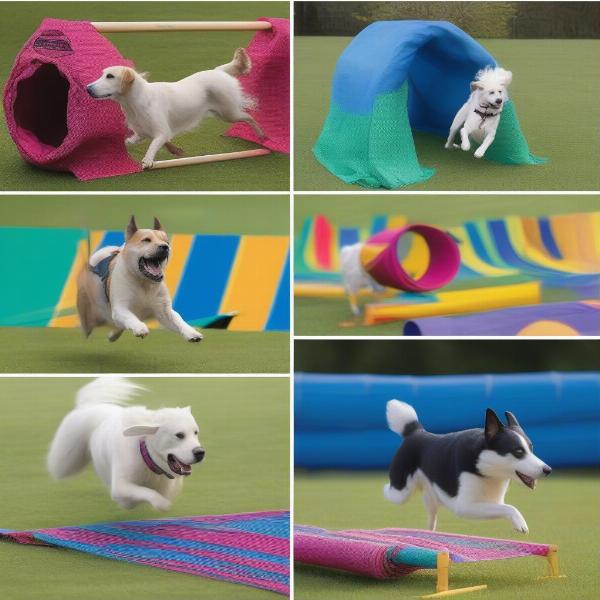Dog obstacle equipment offers a fantastic way to enhance your dog’s physical and mental well-being. Whether you’re a seasoned competitor or simply looking for fun ways to engage your furry friend, this guide will provide you with valuable insights into choosing, using, and maximizing the benefits of dog obstacle equipment. From agility courses to simple backyard setups, we’ll explore the world of canine obstacles and how they can contribute to a happier, healthier life for your dog.
Choosing the Right Dog Obstacle Equipment
Selecting appropriate obstacle equipment depends on various factors, including your dog’s breed, size, age, and activity level. Puppies and senior dogs require gentler introductions and modified equipment compared to energetic adults. Always prioritize safety and choose equipment made from durable, non-toxic materials. For smaller breeds, consider lighter, adjustable obstacles. Larger breeds benefit from sturdy, robust equipment that can withstand their strength and enthusiasm.
Remember to start slowly and gradually introduce new obstacles to avoid overwhelming your dog. Positive reinforcement and encouragement are crucial for building confidence and making the experience enjoyable.
Types of Dog Obstacle Equipment
A wide array of obstacle equipment is available to cater to different training goals and preferences. Some popular options include:
- Tunnels: These provide a fun and stimulating challenge, encouraging dogs to crawl and navigate enclosed spaces.
- Jumps: Adjustable height jumps help improve a dog’s leaping abilities and coordination.
- A-frames: These slanted ramps test balance and coordination.
- Weave Poles: Weaving through poles enhances agility and body awareness.
 Types of dog obstacle equipment
Types of dog obstacle equipment - Pause Tables: These platforms teach dogs to pause and maintain composure.
Consider a sporty dog harness for optimal comfort and control during training.
Setting Up a Dog Obstacle Course
Whether you have a large backyard or a smaller indoor space, you can create a stimulating obstacle course for your dog. Start with a few basic obstacles and gradually expand as your dog progresses. Ensure the area is safe and free of hazards. Use positive reinforcement techniques, such as treats and praise, to motivate your dog. Keep training sessions short and engaging to maintain your dog’s interest. If training indoors, ensure adequate space and remove any fragile objects.
Benefits of Dog Obstacle Training
Beyond the physical benefits, obstacle training offers numerous advantages for your dog’s mental and emotional well-being:
- Improved Fitness: Obstacles promote cardiovascular health, muscle strength, and flexibility.
- Enhanced Coordination and Balance: Navigating obstacles develops body awareness and improves motor skills.
- Mental Stimulation: Obstacle training provides a mental workout, preventing boredom and reducing destructive behaviors.
A dog headlamp can be useful for early morning or late evening training sessions.
- Stronger Bond: Working together through obstacles strengthens the bond between you and your dog.
- Confidence Building: Overcoming challenges builds confidence and self-esteem.
Is Dog Obstacle Training Right for My Dog?
Most dogs can benefit from obstacle training, regardless of age or breed. However, certain medical conditions may require modifications or limitations. Consult your veterinarian to determine if obstacle training is suitable for your dog’s specific needs.
Conclusion
Dog obstacle equipment offers a fun and enriching way to enhance your dog’s physical and mental well-being. By choosing appropriate equipment, creating a safe and stimulating environment, and utilizing positive reinforcement techniques, you can help your dog thrive and enjoy the many benefits of obstacle training. Consider incorporating dog obstacle equipment into your dog’s routine for a healthier, happier, and more fulfilling life. A hog dog vest might be suitable for certain breeds or activities.
FAQ
- What age can I start obstacle training with my puppy? Start with simple, age-appropriate obstacles once your puppy has completed basic obedience training, usually around 6 months old.
- How often should I train my dog with obstacles? Start with short sessions 2-3 times a week and gradually increase frequency and duration as your dog progresses.
- What if my dog is afraid of an obstacle? Never force your dog. Use positive reinforcement, patience, and gradual desensitization to help them overcome their fear.
- Can senior dogs participate in obstacle training? Yes, but modify the obstacles and keep sessions shorter and less strenuous.
- Where can I find dog obstacle equipment? Pet stores, online retailers, and specialized dog agility suppliers offer a wide selection.
- What are some common mistakes to avoid in obstacle training? Avoid pushing your dog too hard, using punishment, or choosing inappropriate equipment.
- How can I make obstacle training more fun for my dog? Incorporate games, toys, and plenty of praise to keep your dog motivated and engaged.
ILM Dog is a leading international online resource dedicated to providing expert advice on dog care, training, and well-being. We offer comprehensive information on breed selection, health, nutrition, behavior, and much more. Our mission is to empower dog owners with the knowledge and resources they need to provide the best possible care for their furry companions. For expert advice tailored to your dog’s unique needs, contact us at [email protected] or +44 20-3965-8624. ILM Dog is committed to helping you and your dog live a happy, healthy life together.